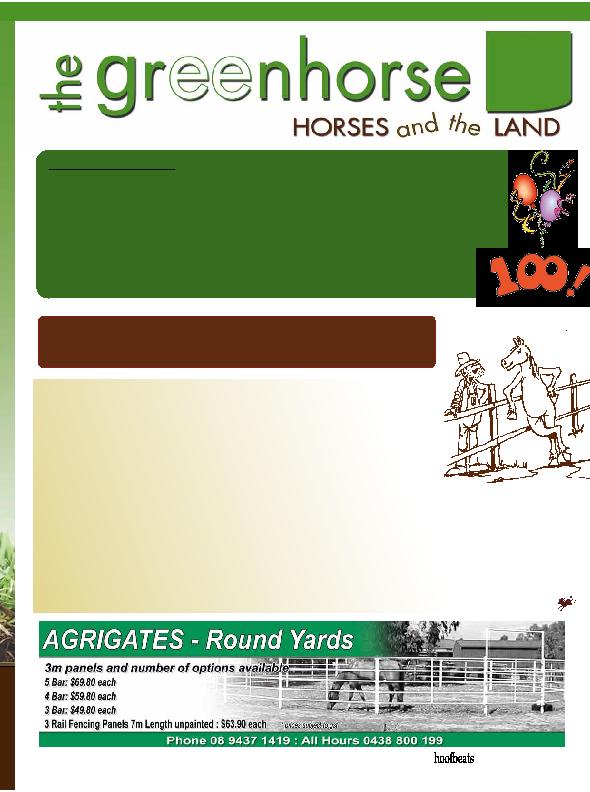
October November 2012
Growing Equine Herbs
Weed Watch
Horse Sick Paddocks
inforMation eXcHange
Readers' letters, tips and queries
talking Point...
Number
100
One Hundred Issues OF THe Green HOrse
This issue marks the 100th edition of The Green Horse feature! First published in the April/May 1996 issue of Hoofbeats, The
available in those pre-internet days and even today is scattered across the net and requires indepth research) to small and
land care and those with hands-on experience of managing horses and the land. Many Hoofbeats readers tell us that The Green
Horse is the only horse magazine their partners read and it causes family squabbles as to who gets to read it first when their
magazine arrives, and they comment on how much they enjoy the different articles on a diverse range of topics.
Many thanks to all our contributors for supporting this feature over the last 16 years and also to our readers for making
The Green Horse such an integral part of Hoofbeats magazine.
Starch is in fact a major cause of
laminitis and is the primary reason
why grains or grain based pellets
and sweet feeds can not be fed to
horses. The key to the safety of
native grasses is they can only store
small amounts of starch. So while
they contain starch, and starch
can most certainly cause laminitis,
they don't contain enough starch to
cause issues.
Temperate introduced grasses like
ryegrass and oats on the other hand
store most of their sugars as water
soluble sugars and there is no limit
to how much sugar these plants can
store away. They can accumulate in
excess of 30% of their dry matter as
sugars, rendering them completely
unsafe for laminitic horses.
Native grasses really do present
an attractive alternative to more
Sugar and Starch
Dear Green Horse,
Thank you for the article `Why
Use Australian Native Grasses'
in the August/September issue of
The Green Horse. Native grasses
truly are a wonderful resource
for Australian horse owners and
something we all need to learn
more about.
I did, however, just want to add a
correction to the article about Native
Grasses. Dr Chivers correctly points
out that some native grasses tend to
be safer for horses who need diets
with a low sugar content. However,
the reason given for this relative
safety of native grasses is because
native grasses store their sugars as
starch and `starch does not cause
these issues (with laminitis)'.
NSW also intends to follow the
lead of Queensland and Victoria
in requiring a PIC before health
certificates will be provided for
horse exports and may also have
event organisers record the PIC for
horses in competition, as is already
done in Queensland.
To apply for a PIC in NSW visit
commonly known pasture grasses
for all of us managing easy keepers
prone to laminitis and I look
forward to future issues and more
information about them.
Dr Nerida Richards
Equilize Horse Nutrition Pty Ltd
Pic update
In the June/July 2012 edition of
The Green Horse, no 98, Julie
Fiedler from Horse SA outlined the
reasons for Property Identification
Codes and the requirements for
horse and livestock owners in each
Australian state. Since then some of
the regulations have changed. As
of the 1st of September it became
mandatory for anyone who keeps
horses in NSW to apply for a PIC
for the land where the horses are
kept. This applies even if only one
horse is owned.

